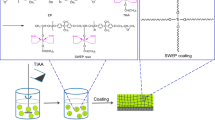Abstract
Waterborne two-component acrylic-epoxy coatings are gaining popularity as topcoats in moderate duty industrial and high performance architectural (HIPAC) applications. This increased popularity is due to their attractive handling, application, and performance properties, along with their low solvent content and odor. The objectives of this work were to characterize the cure and property development of these coatings, evaluate performance properties of cured films, and investigate a new epoxy resin dispersion in existing acrylic-epoxy formulations. These evaluations confirmed that existing acrylic-epoxy coatings have long pot life and short dry times while displaying a range of chemical resistance and physical properties. IR spectroscopy and differential scanning calorimetry (DSC) results indicated that the extent of cure at ambient conditions over a 21-day period was minimal; however, dynamic mechanical analysis (DMA) and solvent swell results did illustrate noticeable crosslink density development under these conditions. DSC results demonstrated more complete reaction and cure after heating. Direct substitution of a novel epoxy resin dispersion into these formulas resulted in lower required solvent content, shorter dry time, higher gloss, higher crosslink density, and improved water and scrub resistance.
Similar content being viewed by others
References
Mercurio, A., “Advances in Waterborne Coatings for the 1990s,”Amer. Paint Coat. J., January 20, pp. 36–45 (1992).
Klepser, R.J., “Water Based Maintenance Coatings Systems,”Proc. of Maintaining Structures with Coatings, SSPC 91, Steel Structures Painting Council, Pittsburgh, PA, pp. 96–106 (1991).
Eslinger, D.R., “Aliphatic Epoxy Emulsion Crosslinker for Waterborne Coatings,”Journal of Coatings Technology,67, No. 850, 45 (1995).
Barnett, J.E. and Powell, K.L., “Waterborne Epoxy Resins: A Versatile Formulating Tool,”Proc. of the Annual Waterborne, High-Solids and Powder Coatings Symposium, New Orleans, LA, Feb. 3–5, 1988.
Weinmann, D.J. and Smith, C., “Performance of Ambient Cure Waterborne Coatings Based on Solid Epoxy Resin Dispersions,”Proc. of the 23rd Annual Waterborne, High-Solids and Powder Coatings Symposium, New Orleans, LA, Feb. 14–15, 1996.
Technical Bulletin, Ancarez AR550 Waterborne Epoxy Resin, Air Products and Chemicals, Inc., Allentown, PA.
Dubowik, D.A. and Lucas, P.A., “A Novel Water-Borne Epoxy Resin for Zero-VOC, Two-Component Coatings,”J. Oil & Colour Chemists’ Assoc., 84, A3, 126 (2001).
Dickenson, J.B., Private communication on the properties of epoxy resins, May 2001.
Hill, L.W., “Structure/Property Relationships of Thermoset Coatings,”Journal of Coatings Technology,64, No. 808, 29 (1992).
Author information
Authors and Affiliations
Additional information
7201 Hamilton Blvd., MailStop R3108, Allentown, PA 18195-1501.
Rights and permissions
About this article
Cite this article
Hegedus, C.R., Pepe, F.R., Dickenson, J.B. et al. Waterborne acrylic-epoxy coatings. Journal of Coatings Technology 74, 31–39 (2002). https://doi.org/10.1007/BF02720162
Issue Date:
DOI: https://doi.org/10.1007/BF02720162




